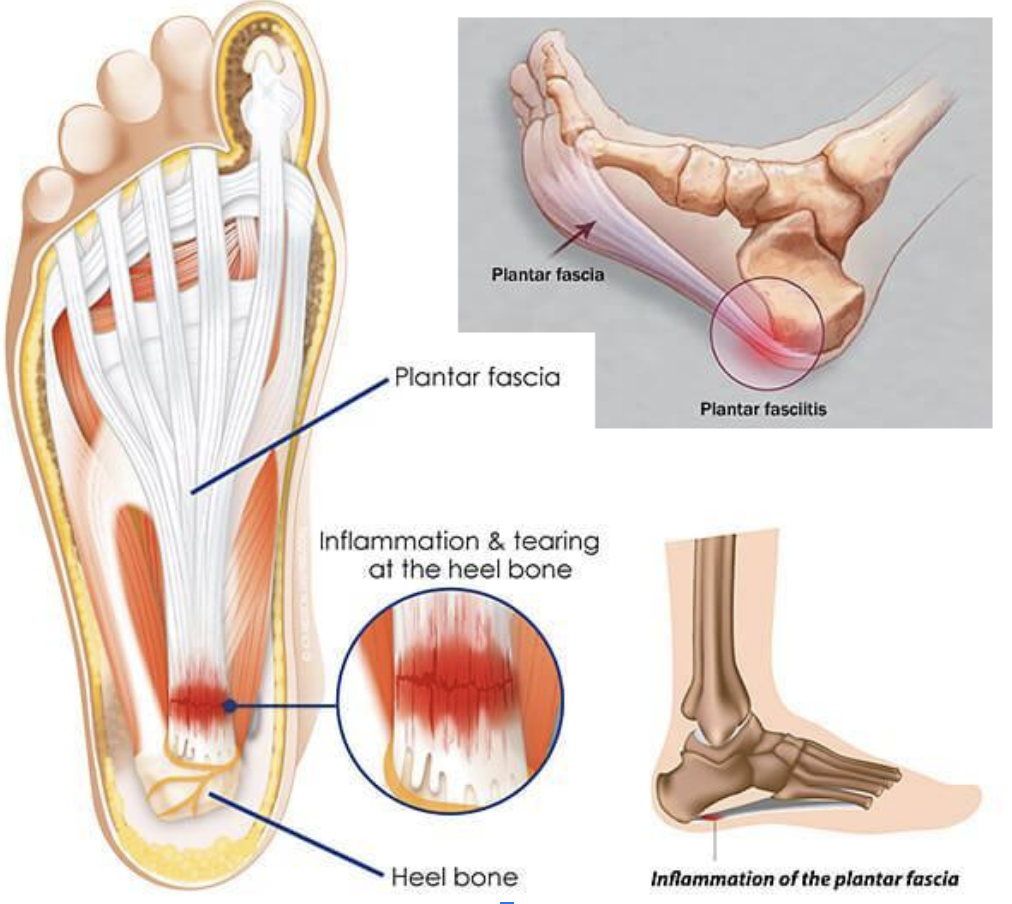Plantar fasciitis can be a real showstopper. Whether you’re an athlete, someone who spends long hours on their feet, or simply going about your daily routine, stabbing heel pain can quickly put a damper on life. At ADAPT Recharge, a 1-on-1 physical therapy and chiropractic clinic focused on mobility training and manual therapy, we’ve seen firsthand how frustrating and limiting this condition can be.
In this blog, we’ll break down what plantar fasciitis is, what might be causing it, and—most importantly—share actionable steps you can take right now to start feeling relief. Plus, we’ll explain how our specialized approach at ADAPT Recharge can help you recover and regain full mobility.
Let’s jump right in.
What is Plantar Fasciitis?
Plantar fasciitis, often confused with general foot pain, is inflammation or irritation of the plantar fascia—a thick band of tissue that runs along the bottom of your foot, connecting your heel to your toes. This condition is particularly notorious for causing sharp, stabbing pain, especially with your first steps in the morning or after prolonged periods of inactivity.
Common Causes
There isn’t a single cause of plantar fasciitis; instead, it usually results from a combination of factors:
- Overuse: High-impact activities like running, dancing, or even standing for long periods can cause excessive strain on the plantar fascia.
- Poor footwear: Wearing unsupportive shoes (like flip-flops or old sneakers) can increase stress on your arches.
- Foot mechanics: Flat feet, high arches, or other biomechanical issues can lead to poor weight distribution and excess tension on the fascia.
- Tight calf muscles: Limited ankle flexibility can overload the plantar fascia as your foot compensates during walking or running.
Recent research, like the studies mentioned in the Physio Network articles, indicates that plantar fasciitis might be better classified as a degenerative condition rather than just an inflammatory one. This means treatment requires addressing the underlying causes—like tension and tissue health—rather than just focusing on reducing inflammation.
How to Manage and Overcome Plantar Faciitis: Practical Steps
So, how do you deal with plantar fasciitis effectively? It requires a combination of proper care, mobility training, and manual therapy. Here’s a roadmap to get you started.
1. Stretching and Mobility Exercises
The first step in relieving plantar fasciitis pain is improving flexibility in the calf muscles and plantar fascia. Regular stretching helps reduce tension and improve the elasticity of these tissues. Try the following stretches:
2. Strengthening Exercises
Strengthening the muscles in your feet and lower legs is equally important for supporting the plantar fascia and preventing future flare-ups.
3. Manual Therapy and Chiropractic Care
At ADAPT Recharge, we believe in addressing the root cause of plantar fasciitis through 1-on-1 physical therapy and manual therapy. By assessing the entire kinetic chain—from your feet to your knees, hips, and even lower back—we can identify any misalignments or biomechanical issues contributing to your pain.
What Manual Therapy Involves:
- Soft Tissue Mobilization: We focus on releasing tension and improving blood flow to the plantar fascia and surrounding muscles.
- Joint Mobilization: Ensuring proper foot and ankle mobility is key to relieving plantar fascia stress.
Chiropractic Adjustments: Misalignments in the foot, ankle, or even lower spine can change how weight is distributed across your feet, exacerbating the condition. We address these issues through targeted adjustments, helping to restore balance and reduce strain.
4. Rest and Recovery
Giving your body time to heal is crucial. While it’s important to stay active, overdoing it can worsen your symptoms. Use these tips to find a balance:
- Limit high-impact activities: Reduce running, jumping, and standing for long periods while your plantar fascia heals.
- Ice your foot: After activity, ice the affected area for 15-20 minutes to reduce any swelling or pain.
Elevate: When sitting, prop your foot up to help decrease any swelling.
How ADAPT Recharge Can Help
At ADAPT Recharge, we take a unique approach to treating plantar fasciitis. We believe that every patient is different, so we offer personalized, 1-on-1 physical therapy sessions to truly understand and address the root causes of your pain. Whether it’s through manual therapy, mobility training, or a full-body biomechanical assessment, our goal is to provide lasting relief and prevent future injuries.
Unlike clinics that simply focus on the symptom, we aim to correct the underlying issues through comprehensive care, addressing everything from muscle tightness to misalignment in the kinetic chain. We’re here to empower you with tools and strategies that work for your body—not just temporary fixes.
Practical Exercise Program for Plantar Fasciitis Relief
If you’re battling plantar fasciitis, the good news is there are exercises you can start doing right away to help reduce pain and improve your mobility. At ADAPT Recharge, we focus on mobility training and manual therapy, so our approach is rooted in simple, effective movements that don’t require fancy equipment. The following exercise routine is designed to stretch, strengthen, and mobilize the muscles and tissues around the foot and ankle—key to relieving plantar fasciitis pain.
1. Calf Stretch (Wall Stretch)
Tight calf muscles can put extra strain on the plantar fascia, so stretching them out is crucial. Here’s how to do it:
- How to perform:
- Stand facing a wall with both hands on it for support.
- Step one leg back, keeping the heel on the ground and the knee straight.
- Bend the front knee slightly while leaning into the wall until you feel a stretch in the calf of the back leg.
- Hold for 30 seconds and switch sides.
- Repeat 2-3 times per leg.
Why it helps: Stretching your calves helps reduce tension on the Achilles tendon and plantar fascia, making each step less painful.
2. Plantar Fascia Stretch (Towel or Belt Stretch)
This simple stretch targets the plantar fascia directly and can help loosen it up, especially in the mornings when it’s often tight.
- How to perform:
- Sit down with your legs extended.
- Loop a towel or belt around the ball of your foot and gently pull it toward you.
- You should feel a stretch along the bottom of your foot and up your calf.
- Hold for 20-30 seconds and repeat 3 times on each foot.
Why it helps: Stretching the plantar fascia itself can relieve some of the tension contributing to the pain.
3. Toe Curls with a Towel (Foot Strengthening)
This exercise strengthens the small muscles in your foot, providing more support to the plantar fascia.
- How to perform:
- Sit in a chair with a towel laid flat on the floor in front of you.
- Place your foot on the towel and use your toes to scrunch the towel toward you.
- Release the towel and repeat the motion.
- Perform 2 sets of 10-15 repetitions per foot.
Why it helps: Stronger foot muscles help to better support your arches and reduce the load on the plantar fascia.
4. Heel Raises (Calf Strengthening)
Strengthening your calf muscles can take some of the load off your plantar fascia, helping distribute the impact forces more evenly.
- How to perform:
- Stand on the edge of a step with your heels hanging off.
- Slowly raise your heels as high as possible, then slowly lower them below the level of the step.
- Perform 2-3 sets of 10-15 reps.
Why it helps: Strengthening your calves supports proper foot mechanics, reducing strain on the plantar fascia.
5. Foot Rolling (Massage)
Using a ball or foam roller to massage the bottom of your foot can help loosen up the plantar fascia and reduce inflammation.
- How to perform:
- Sit in a chair and place a small ball (like a tennis or lacrosse ball) under your foot.
- Roll your foot back and forth over the ball, focusing on any tight or tender areas.
- Do this for 1-2 minutes per foot, especially in the mornings or after long periods of standing.
Why it helps: Rolling your foot helps break up adhesions and increase blood flow to the plantar fascia, aiding in recovery.
6. Ankle Mobilizations (Dynamic Stretching)
Improving ankle mobility can prevent overloading the plantar fascia by allowing for smoother, more efficient movement during walking or running.
- How to perform:
- Stand facing a wall with one foot slightly in front of the other.
- Keeping your heel on the ground, bend your front knee forward until it touches the wall.
- Hold for 2-3 seconds and return to the starting position.
- Perform 2 sets of 10-15 repetitions per leg.
Why it helps: Better ankle mobility reduces compensatory movements in the foot that can lead to plantar fascia stress.
When to Do These Exercises
For best results, aim to perform these exercises at least once a day. If your plantar fasciitis is severe, start slowly and increase the intensity as your pain improves. Consistency is key—over time, these exercises can help improve your strength, mobility, and overall function, leading to less pain and a faster recovery.
At ADAPT Recharge, we know that every case of plantar fasciitis is different. While these exercises can provide relief, they may not address the root cause of your condition. That’s why we offer a 100% FREE assessment with one of our experienced practitioners to help you figure out exactly what’s causing your pain. With personalized 1-on-1 physical therapy and chiropractic care focused on mobility training and manual therapy, we’re here to guide you every step of the way to a pain-free life.
Ready to take the next step? Reach out to schedule your assessment and let’s get started on your journey to recovery!




